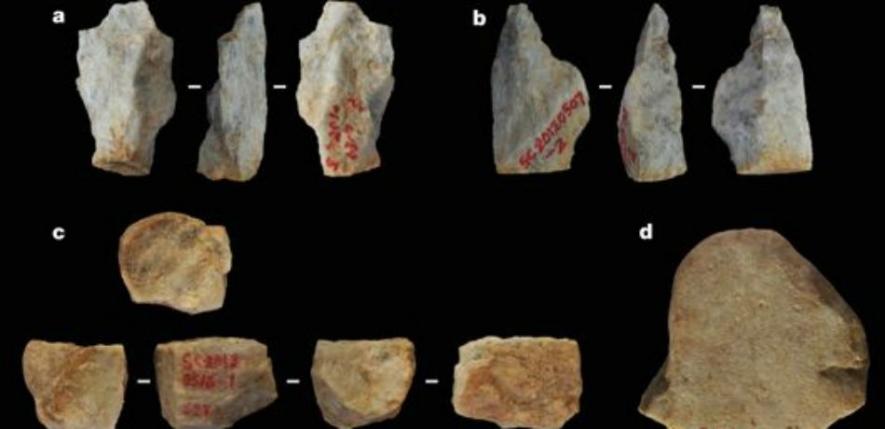Time to Rethink Where and When Modern Humans Come From?

With the latest discovery of ancient stone tools in Shangchen, China, scientists are coming up with modifications to the current theories of human migrations and settlements. These are the oldest stone tools found out of Africa yet, dated to be around 2 million years old. Prior to this, the oldest evidence of humans out of Africa had been located in Georgia, which was around 1.8 million years old. These stone tools in Shangchen predate the Georgia ones by 270,000 years, suggesting that our timeline of humans leaving Africa might have to be set back by at least as many years.
The study, led by Zhaoyu Zhu from the Chinese Academy of Sciences and Robin Dennell from University of Exeter, was conducted with excavations spanning over a period of 13 years, from 2004 to 2017. These excavations led to the unearthing of 80 stone artefacts buried in alternating layers of two types of soil — loess and palaeosol.
Also Watch: Where did People of India and Other Parts of South, Central Asia Come From?
Loess is formed with the deposits of wind-blown dust, and palaeosol is “fossil soil”, essentially ancient compositions of soil which have been preserved till date due to being buried under sediment or volcanic deposits. While loess was formed during cold and dry conditions, the palaeosol developed in a warm and wet climate.
Out of the 96 total stone tools found, 80 were found in 11 layers of palaeosol, and 16 were found in six layers of loess. So these ancient humans inhabited the Chinese Loess Plateau under different climactic conditions, and in a “repeated—but not necessarily continuous—hominin occupation,” according to the paper published in Nature. This occupation stretched across almost a million years, between 2.12 and 1.26 million years ago.
The varying climactic conditions at the time of this hominin occupation also indicates that our species’ cousins already had the ability to adapt to a range of environmental constraints. The high altitude of Shangchen would have subjected this population to a cold and harsh habitat.
The stone tools have been classified under different categories, including scrapers, notches, borers and picks.
According to Dennell, the discovery means reconsidering the “timing of when early humans left Africa.” Anthropologist John Kappelman also finds the possibility of an earlier migration plausible. “The roughly 14,000-kilometre trek from eastern Africa to eastern Asia represents a range expansion of dramatic proportions,” he wrote. “Yet even with a dispersal rate of only 5-15km per year, a value well inside the daily foraging range of modern hunter-gatherers, the distance between Africa and Asia could have been covered in just 1,000–3,000 years.”
However, other theories have also been proposed to explain the location and age of these tools.
While it is believed that the ancient human specie, Homo erectus, was the one to first migrate from Africa, some scientists feel that these tools along with the fossils found in Georgia suggests that a different human species may have left Africa first since there is no evidence to suggest that Homo erectus had even evolved by this time.
Michael Petraglia, a paleoanthropologist at Max Planck Institute, said, “It is entirely possible that Homo erectus occupied China at this time, but given the age of the site, and the possibility that artifacts may be found at even earlier ages, another member of the genus Homo may be occupying Asia, such as a Homo habilis-like ancestor.”
Homo sapiens first migrated from Africa only 60,000 years ago, and these tools do not prove that they were made by ancestors of modern humans who may have migrated early. Many hominin species left Africa in different migrations. “Some populations got all the way over to eastern Asia, but we have to imagine that these were small, sort of hunting-and-gathering populations. And while they may have mated across East Asia, it doesn’t mean they survived for a long period of time. Some populations might have become isolated, and some might have become extinct,” Petraglia says.
Also Read: Who Made These Advanced Stone Tools in India?
A minority also believes that these stone tools suggest that a more primitive human ancestor may have actually originated in Eurasia, evolving into the Homo erectus and migrating to Africa. But no evidence to prove this conjecture exists.
With the paleontological fieldwork being carried out in China now steadily increasing, scientists expect to find more and more such discoveries that would lead to restructuring of the known human history.
“I’ve always said that once the Chinese researchers start looking for evidence on a similar scale as all the money spent in Africa, things will turn up!” said University of Wollongong paleoanthropologist Gerrit van den Bergh
Get the latest reports & analysis with people's perspective on Protests, movements & deep analytical videos, discussions of the current affairs in your Telegram app. Subscribe to NewsClick's Telegram channel & get Real-Time updates on stories, as they get published on our website.
















